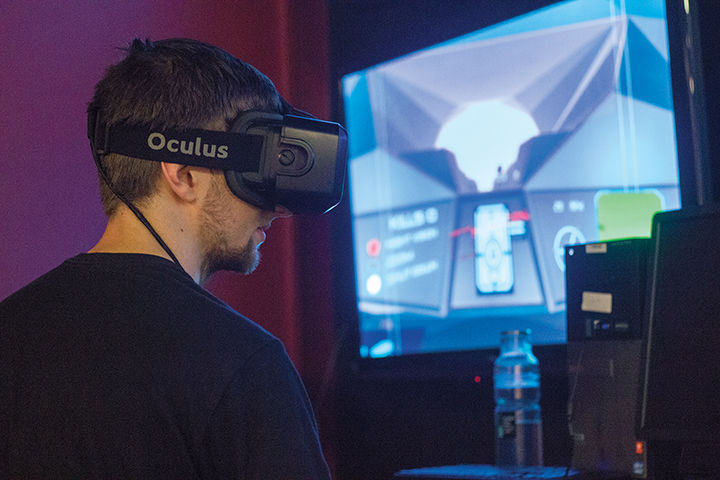
The University of Maryland Virtual Reality Club set up an Oculus Rift demo at TerpZone in the Adele H. Stamp Student Union on Aug. 31, 2015. Sophomore computer science major Galen Stetsyuk, a member of the Virtual Reality Club, tests the virtual reality demo.
Andre Pimenta put on a pair of Oculus Rift goggles Monday and suddenly the sophomore was operating a tank, seeking out and shooting at enemy vehicles.
Sophomore computer science majors Galen Stetsyuk and Mikhail Sorokin spent the summer working on a two-person virtual reality video game called Core Disruption. Starting Monday night, students like Pimenta were able to try out a free demo of the game using Oculus Rift head-mounted display technology at TerpZone in the Stamp Student Union.
“I enjoyed [the game] a lot,” said Pimenta, an information systems major. “[The Oculus Rift] is a cool technology because it makes you a more active player. You can look around and it reacts to you instead of just toggling around like in a normal game.”
After working briefly on a motorcycle ride demo together earlier in the year, Sorokin and Stetsyuk, who are both members of the Virtual Reality Club on the campus, decided to take advantage of the technology available to them in the computer science department and work on their own video game.
“The Rift is extremely immersive. … Even playing normal games now, I’m like, ‘I’d rather be in there,’” Stetsyuk said. “We wanted to bring that kind of unique experience to more people and give students a chance to come try it out for themselves.”
About a dozen people came to try the game the first night, and demos will also take place Tuesday, Wednesday, Friday and Saturday nights from 5 p.m. to 7 p.m. Stetsyuk said the demos went well and most people wanted to keep playing after their first try.
Josh Ashkenazy, a freshman enrolled in letters and sciences, said the demo was his first experience with virtual reality and with the Oculus Rift and he really enjoyed it. As a gamer, he said, he thinks the technology could be the next step in immersive gaming.
“I was really impressed. I think it has a lot of potential,” Ashkenazy said. “It kind of gives it a whole other level of depth to the experience.”
Sorokin said though the Oculus Rift can make video games more fun, it’s not just for “computer science nerds” and could have applications in other fields as well.
“It can be used for training in the military or in medical fields,” he said. “We want to try and work with students across different majors and explore different ways this technology can be used.”
Stetsyuk said with former students like Brendan Iribe, one of the co-founders of the Oculus VR company, this university should be a driving force in virtual reality innovation.
Iribe donated $31 million to the university last year, the largest gift in university history, to help create the Brendan Iribe Center for Computer Science and Innovation.
Stetsyuk and Sorokin said they want to start their own company to find practical uses for virtual reality technology in different fields. In the meantime, Stetsyuk and Sorokin will continue development of the Core Disruption game and aim to have it finished by the end of next summer.
“If people just try it out, they’re going to want to get involved,” Stetsyuk said. “As people realize the other applications it has, a whole new market can open up.”
Stetsyuk said this video game will appeal to gamers first, but it’s important for different people to gain exposure to the technology so new uses can be discovered.
Sorokin said his mother once asked him if he could make a garden for her using the technology.
“That’s the idea,” he said. “That even with something like that, something simple, we could design it in [virtual reality] and apply it in real life.”



